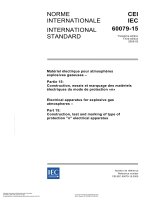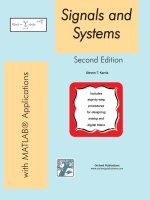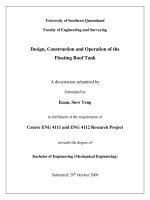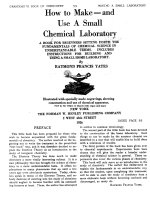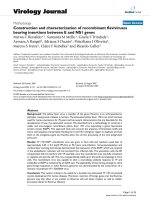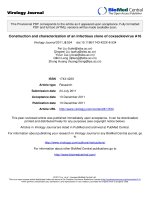Gas Station Construction and Maintenance, Petroleum systems Contractor Nevada and Arizona_1 ppt
Bạn đang xem bản rút gọn của tài liệu. Xem và tải ngay bản đầy đủ của tài liệu tại đây (167.39 KB, 12 trang )
UFC 3-460-03
21 JANUARY 2003
11
Chapter 2
PIPELINE SYSTEMS
2.1. On-Base Pipelines. On-base pipelines are used to fill base fuel storage tanks, withdraw fuel from
base storage tanks, fill trucks, transfer fuel between base storage and operating storage tanks, and fill
aircraft from hydrant operating storage tanks and dispensing systems.
2.1.1. Commercial Pipelines. Commercial pipelines deliver fuel to the base fuel storage tanks.
These pipelines are usually underground except at tie-in connections to the base pipelines. These
pipelines are constructed on government property by issuing real estate easements. Typically, cross-
country pipelines are owned, operated, and maintained by civilian agencies. When a pipeline system
is under contract to a civilian agency, civilian responsibility for maintaining the pipeline usually
terminates at some point near where the pipeline enters the base. From this point to the bulk fuel
storage area, the responsibility for maintenance is assigned to the BCE. The BCE is authorized to
perform emergency maintenance on on-base commercial pipelines, if necessary, to protect against
environmental damage to public property or meet emergency wartime mission requirements. The real
estate easement agreement with the pipeline owner takes note of this and provides for suitable
contractor reimbursement to the government. Government-owned or -leased cross-country pipeline
systems and marine facilities are in common use in oversea areas. In some areas Air Force personnel
maintain these systems.
2.1.2. Bulk Fuel Storage Facility Pipelines. Petroleum fuels may be supplied to bulk fuel storage
tanks by inter-terminal pipelines that may be dedicated to serving the particular facility or may be
commercial pipelines handling several types or grades of fuel for more than one user. In some cases,
the pipeline will be an installation pipeline. Where more than one type of fuel is received or
unloaded, separate pipelines and unloading facilities are typically provided for each type of fuel.
2.1.3. Transfer Pipelines. These pipelines carry fuel between base storage, transfer pumphouses, and
truck fill stands or hydrant systems. Typically, these pipelines are underground except in the
immediate area of the facility involved. Most facilities have separate issue and receipt lines;
however, some facilities use a single line for both.
2.2. Operating On-Base Petroleum Systems. The FMF is responsible for operating on-base
petroleum systems, according to AFI 23-201, Fuels Management, and T.O. 37-1-1. The BCE provides
the FMF with a current on-base pipeline capacity (in U.S. gallons).
2.3. Maintenance of On-Base Pipelines.
2.3.1. Inspecting Aboveground Piping. Visually inspect for leaks or drips at the same time that other
maintenance tasks are performed in these areas. Leaks in an aboveground pipeline require welding
for permanent repair (see API Recommended Practice [RP] 1107, Pipeline Maintenance and Welding
Practices). Approvals from the MAJCOM fuels engineer, base safety, base environmental engineer,
and the base fire department are required before beginning welding or hot work in connection with
repairs.
Simpo PDF Merge and Split Unregistered Version -
UFC 3-460-03
21 JANUARY 2003
12
2.3.2. Inspecting Underground Piping. All LFM personnel should be aware of the various
underground pipeline routes and make a general visual surveillance when driving by or working in
these areas. The pipeline should be walked at least once a year. Leaks in underground pipelines can
sometimes be detected by fuel surfacing on the ground, fuel runoff in the storm drainage system, fuel
in underground pits or manholes, dead vegetation, or the continuous odor of fuel in a particular area.
Investigate any suspicious circumstances. Consult the base environmental coordinator for guidance
before excavating the soil. Periodic documented cathodic protection surveys should be accomplished
in accordance with AFI 32-1054, Corrosion Control.
2.3.3. Pipeline Testing. Pipelines must be tested annually for leaks. The MAJCOM fuels engineer
may authorize an equivalent methodology as long as state environmental requirements are met.
Pressure tests are affected by weather, so it is best to do them in the spring or fall when fuel, ground,
and air temperatures are similar. An overcast day or early in the morning would be preferable to
lessen the solar effects on aboveground lines. Maintain all leak test records in the LFM shop for five
years unless environmental requirements dictate longer. Send copies of these records to the
MAJCOM fuels engineer if requested. Use the following testing approach unless state requirements
are more stringent:
2.3.3.1. Annual Pressure Testing. Pressure-test all on-base fuel piping systems annually using
existing system pumps. Pressurize unloading, loading, transfer, and hydrant dispensing piping
systems by running the appropriate pumps against a closed system until deadhead pressure is
reached. Close appropriate valves to trap this pressure in the system, then turn off the pumps.
NOTE: Some ball valves do not provide isolation and require a differential pressure (DP) to seat,
so blind flanges may be required. Take pressure gauge readings within fifteen minutes after
allowing sufficient time for the fuel pressure to stabilize. Visually check all aboveground piping
and piping in concrete pits for leaks. Audibly check closed valves for sound as evidence of an
internal valve leak. If no visible or audible leaks occur, then take pressure gauge readings every
fifteen minutes for the first hour, and once every half-hour for the next hour. Total time for the
pressure test will be two hours. Document all pressure tests by recording the following:
2.3.3.1.1. Name of system test (i.e., refuel header, defuel header, lateral pipelines). Provide
facility number.
2.3.3.1.2. Date of test and weather conditions (e.g., sunny and 27 °C [80 °F]; cloudy and 18 °C
[64 °F]). NOTE: Record any weather change during the test period.
2.3.3.1.3. Pressure readings:
2.3.3.1.3.1. Start (approximate local time) pressure.
2.3.3.1.3.2. Fifteen minutes (approximate local time) pressure.
2.3.3.1.3.3. Thirty minutes (approximate local time) pressure.
2.3.3.1.3.4. Forty-five minutes (approximate local time) pressure.
2.3.3.1.3.5. One hour (approximate local time) pressure.
2.3.3.1.3.6. One and one-half hours (approximate local time) pressure.
2.3.3.1.3.7. Two hours (approximate local time) pressure.
2.3.3.2. Five-Year Hydrostatic Test. Perform a hydrostatic pressure test every five years on all
underground fuel transfer pipelines (product is typically the test media for this test). The
MAJCOM fuels engineer sets the specific year. A hand-operated hydraulic pump, or equivalent,
Simpo PDF Merge and Split Unregistered Version -
UFC 3-460-03
21 JANUARY 2003
13
with a built-in reservoir tank supplies hydrostatic pressure. This takes the place of the annual
pressure test. The hydrostatic test may be conducted using a dual-pressure, temperature-
compensating pressure test conducted at the same pressure specified in paragraph 2.3.3.2.2 with
MAJCOM fuels engineer approval. The test vendor must have an independent third-party review
of the test.
2.3.3.2.1. To test the pipe, first isolate the section being tested with blind or spectacle flanges.
If DBB valves will hold the pressure, blind flanging is not required. NOTE: filter/separators
(F/Ss), thermal relief valves, safety valves, and sight glasses may have to be removed or isolated
by blind/skillets.
2.3.3.2.2. Using a hand-operated hydrostatic pump, perform a static pressure test to the lesser
of 1.5 times the system dead head pressure or 1.896 megapascals (275 pounds per square inch
gauge) maximum. Use fuel to perform all tests. Pressure may also be applied with a dead-
weight tester or suitable motor-driven pump.
2.3.3.2.3. Once the pressure is stabilized, record the pressure every 15 minutes for the first
hour, every 30 minutes the second hour, then every hour thereafter. If at the end of the
minimum four-hour test (the longest test possible is recommended. preferably overnight) no
leaks are found, further testing is not required. (Use the procedure described in paragraph
2.3.3.1.) If a leak or excessive pressure change is observed, perform a flow test by
repressurizing the line with the hydrostatic pump. Measure and record the amount of fluid
required to maintain this pressure for four hours. If a leak is found, contact the environmental
flight and take action to repair it. Also, promptly notify the command fuels engineer and DESC
if additional funding is required for repairs, leak detection, and or location. A drop in pressure
could be the result of a decrease in product temperature or absorption by the product of air in
the line. To rule this out, you may repressurize the line and extend the test period to at least 24
hours.
2.4. Off-Base Pipeline Systems. Off-base pipelines are used to transfer petroleum products from
refineries to air bases, terminals, and points of distribution. They are typically owned, operated, and
maintained by civilian contractors (except for government-owned or -leased pipeline systems) and will
vary in size, construction, and operation. Additional factors influencing the operation and type of
system are terrain features (underwater, aboveground, belowground, road and railway crossing,
expansion joints) and age. Pipeline receiving facilities are typically near the base fuel storage area.
These facilities should include an isolation pit, pressure reducing valve and, when used, a pig receiving
facility. The Department of Transportation (DoT) regulates pipelines following Title 49, Code of
Federal Regulations (CFR), Part 195, Transportation of Hazardous Liquids by Pipeline, current edition.
The following subparagraphs will give a general description of these types of pipelines and O&M
procedures that apply to most systems.
2.4.1. Cross-Country Pipelines. Cross-country pipelines are often of the multi-product type. The
system consists of one pipeline and a series of pumping stations. The pumping stations have pumps,
strainers, pressure regulators, valves, scraper sand traps, and a sump tank to collect sludge and debris.
The number of pumping stations in the cross-country system depends on terrain conditions and the
distance the fuel must be transferred.
2.4.2. Off-Base Pipeline Construction. Pipelines are typically constructed of 12.1-meter (40-foot)
long steel pipes welded together and installed aboveground or underground. Pipe diameter varies
from 101 to 355 millimeters (4 to 14 inches), depending on system capacity. For a more complete
Simpo PDF Merge and Split Unregistered Version -
UFC 3-460-03
21 JANUARY 2003
14
understanding of the design and construction of pipelines, see MIL-HDBK-1022A, API RP 1102,
Steel Pipelines Crossing Railroads and Highways, and API Std 1104, Welding of Pipelines and
Related Facilities.
2.4.3. Operations. In an emergency and at oversea commands, Air Force personnel may be required
to take over, operate, and maintain a cross-country pipeline system. The command fuels engineer
will provide technical oversight to the BCE responsible for all maintenance of pipelines acquired by
the Air Force. Before operating a pipeline, the command fuels engineer or his delegated
representative should consider the following:
2.4.3.1. Secure all plans, system diagrams, and information possible to find the location and
function of all components (especially valves) in the system. Some installations may require a
complete engineering study to secure sufficient information for O&M.
2.4.3.2. Reports should be made to decide the necessary manpower for each installation.
Personnel selected should have experience in the type of equipment they will operate. Skilled
engineers, electricians, mechanics, and pump operators are usually required at each pumping
station.
2.4.3.3. Inspect all equipment in the pipeline system to ensure proper working condition. Failure
at one pumping station can cause a complete shutdown of the entire pipeline.
2.4.4. Off-Base Piping System Inspections:
2.4.4.1. Leak Detection. Pressure checks, volume checks, line patrols, and leak detection
apparatuses may be used to detect leaks.
2.4.4.2. Pressure Checks. Pressure-check off-base piping systems annually in the same way
prescribed for on-base piping systems (see paragraph 2.3.3.1). Hydrostatically test new piping
systems in accordance with API RP 1110, Pressure Testing of Liquid Petroleum Pipelines.
Hydrostatically test systems to the lesser of 1.5 times the operating pressure or 1.896 megapascals
(275 pounds per square inch gauge) maximum. During testing, disconnect system components
such as storage tanks or equipment that were not designed for the piping test pressure or protect
them against damage by over-pressure.
2.4.4.3. Volume Checks. Continuous records are kept on volume and temperature of liquid passed
through each pumping station. A difference in meter reading that cannot be accounted for by
temperature corrections between two stations usually indicates a leak, but could also indicate theft,
out-of-calibration meters, faulty temperature sensors, or human error.
2.4.4.4. Line Patrols. Inspections are made by line walkers, vehicles, and light aircraft. Air
patrols should be flown not less than once every three weeks at an elevation of less than 152
meters (500 feet) from the ground and at speeds from 104 to 128 kilometers per hour (65 to 80
miles per hour). The pipeline should be marked with posts or signs at 1.6-kilometer (1-mile)
intervals and at bends. The pilot acts as an observer who checks for unnatural changes in
vegetation color and oil slicks on lakes and streams which are evidence of leaking pipelines; area
construction work (e.g., roads, sewers) that could cross and possibly damage the pipeline; and the
overall condition of the right-of-way. Line walkers or vehicle patrols make detailed inspections
once a year of the entire pipeline, checking the general condition of the right-of-way, valves in
remote areas, supports on aboveground pipelines, and any condition that may indicate a leak.
2.4.4.5. Leak Detection Apparatus. Various types of leak detection apparatus are used by civilian
contractors. Vapor or electronic devices are some of the more common types.
Simpo PDF Merge and Split Unregistered Version -
UFC 3-460-03
21 JANUARY 2003
15
2.4.4.6. API 570 Inspections. Besides routine pipeline inspections, periodic inspections by an
expert certified to the standards of API 570 will provide documentation of remaining pipeline life
and any need for replacement. This may be funded by DESC.
2.5. General Pipeline System Components.
2.5.1. Expansion Joints. Pipelines are arranged to allow for expansion and contraction caused by
changes in ambient temperature. Where possible, accommodate expansion and contraction by
changes the direction of piping runs, offsets, loops, or bends. When this is not practicable, use
flexible ball joint offsets. Do not use expansion devices that use packings, slip joints, friction fits, or
other non-fire-resistant arrangements. Ball-type offset joints are used to accommodate possible
settling of heavy structures such as storage tanks if piping design cannot provide enough flexibility.
Expansion bends, loops, and offsets are designed within stress limitations of American Society of
Mechanical Engineers (ASME) B31.3, Process Piping, and ASME B31.4, Liquid Transportation
Systems for Hydrocarbons, Liquid Petroleum Gas, Anhydrous Ammonia, and Alcohols.
2.5.2. Manual Valves. Manual valves are used on pipelines to control flow and to permit isolating
equipment for maintenance or repair.
2.5.2.1. Full port valves are installed on pipelines to allow pigging.
2.5.2.2. Do not use gate valves in aircraft fueling systems, except where the pipeline is
pigable and absolute shut-off is not required.
2.5.2.3. For specific valve types and locations, see MIL-HDBK-1022A.
2.5.3. Surge Suppressors. If the flow of liquid in a pipeline is suddenly stopped, an excessively high
pressure is instantly created because the kinetic energy of flow is converted to pressure energy. The
resulting shock often causes leaks and damage to connected equipment. A common device designed
to decrease shock in pipelines is a surge suppressor of the diaphragm or bladder type. It is equipped
with a top-mounted liquid-filled pressure gauge, isolation valve, limited bleed-back check valve, and
drains. The surge suppressor will be as close as possible to the point of shutoff that is expected to
cause the shock. Surge suppressors can reduce shock pressure but will not end it entirely.
2.5.4. Miscellaneous. Miscellaneous equipment found in pumping stations include control panels,
gauges, fire-fighting equipment, water detectors, sump pumps, compressed air systems, and
electronic measuring devices. These components vary with the type of system and are considered
accessory equipment for the major components of the system.
2.6. General Pipeline System Repairs.
2.6.1. General Pipeline Leaks. Most pipeline leaks are caused by interior or exterior corrosion. Less
frequent causes of leaks include cracked welds, split seams and joints, separation at collars, buried
flanges, and threaded pipe. Initial repairs can be made by placing clamps over the damaged area and
using sealing epoxy components or gaskets to seal the leak. These repairs are usually temporary and
modern practice is to weld all leaks (API RP 1107). The LFM should make sure that schematics are
annotated to show where major breaks and leaks have occurred in the pipeline.
2.6.2. Pits and Small Leaks. Pits on the exterior of a pipeline are caused by corrosion. If discovered
before a leak develops, repair them by arc welding. Welding a circular patch over the hole may repair
small leaks.
Simpo PDF Merge and Split Unregistered Version -
UFC 3-460-03
21 JANUARY 2003
16
2.6.3. Large Punctures and Holes. Large holes in pipelines usually create a welding safety hazard
because of the spills that have saturated the ground. Clamping a steel plate of the same curvature as
the pipe over the damaged area, using petroleum-resistant rubber for a seal, makes temporary line
repairs; the area may then be cleared of all hazards. The steel plate clamped over the leak can be
permanently welded to the pipe. For most welding operations, the pipeline can stay in service during
repairs; however, if there is danger of the arc penetrating the pipe (thin wall or badly corroded pipe),
the system should be shut down during repairs. All hot work must be approved by the command
fuels engineer, base safety, base bioenvironmental engineer, and base fire department.
2.7. Major Repairs. Major repairs involving several sections of pipe can be done by two methods:
2.7.1. If the pipeline can be taken out of service, replace the damaged section with new pipe.
2.7.2. If the pipeline cannot be taken out of service, a casing can be welded over the damaged
sections. Casings are considered temporary and should be used only under extreme conditions.
2.8. Pipeline Cleaning. Pipelines are cleaned with line scrapers forced through the line by the liquid
being pumped. Intervals between cleanings vary with the size of the pipe and the type of liquid. A drop
in the flow rate, the continual presence of dirt, rust, or particulate in basket strainers, and or shortened
filter life may indicate a need for cleaning. Batching pigs are used to separate fuels and prevent
contamination. Treatment of batching pigs is the same as for line scrapers. Water slugs are not
permitted to separate batches.
2.8.1. Scraper Operation. Decide on the scraper best suited for the operation. Check specifications
to be sure it will pass through all valves and bends. Keep accurate records of the time the scraper is
started and quantity of fuel pumped to trace the progress of the scraper and find the time of its arrival
at the receiving station. It is good practice to bypass meters while scraper sediment is in the line.
The scraper should be run at the minimum velocity (3.2 kilometers per hour [two miles per hour])
with no shutdowns while the scraper is in the line. Shutdowns will permit the scrapings to settle in
front of the scraper, causing it to become stuck (this usually requires cutting the line to retrieve it).
2.8.2. Scraper Tracing. Several methods are used to find scrapers stuck in lines. The knife-type
scrapers make sufficient noise to be followed by line walkers. Brush-type scrapers are relatively
silent and require a transmitting device to reveal their exact location. Their general location can be
found from the time and quantity of fuel pumped before the stoppage occurred. Special devices
include:
2.8.2.1 Noisemakers fastened to the scraper.
2.8.2.2 Directional antennas.
2.8.2.3. Radioactive material that can be found with a Geiger counter.
2.8.2.4. Magnetized core in the scraper that can be detected with a magnetometer.
Simpo PDF Merge and Split Unregistered Version -
UFC 3-460-03
21 JANUARY 2003
17
Chapter 3
MECHANICAL SYSTEMS
3.1. General Information. This chapter covers receiving, offloading, fill stand, pipelines, and gas
station facilities. The components common to each of these systems, as well as the components specific
for each system, are described in this chapter. These facilities must have an appropriate system to
contain spills. Contact the base environmental coordinator for applicable environmental requirements
and refer to MIL-HDBK-1022A for design criteria. Typical applications include direct offloading
systems and stripper pumps.
3.2. Pumps. In mechanical systems, pumps are used for unloading, transferring, and dispensing fuels.
There are several types of pumps used in fueling systems.
3.2.1. Rotary positive displacement pumps (Figure 3.1) or self–priming centrifugal pumps are used
where suction lifts are high or where the pump may frequently lose prime. These pumps must have
an internal pressure relief or a pressure relief must be installed on the downstream side. Positive
displacement pumps will not be used as product issue or transfer pumps.
Figure 3.1. Rotary Vane Pump.
Simpo PDF Merge and Split Unregistered Version -
UFC 3-460-03
21 JANUARY 2003
18
3.2.2. Horizontal split-case centrifugal or turbine pumps (Figures 3.2 and 3.3) are used as transfer
pumps on aboveground tanks and installed in a position that creates positive or flooded suction.
Vertical turbine pumps are used to pump from underground or cut-and-cover tanks. A “can” pump is
another type of vertical turbine pump.
Figure 3.2. Horizontal Split-Case Pump.
Simpo PDF Merge and Split Unregistered Version -
UFC 3-460-03
21 JANUARY 2003
19
Figure 3.3. Vertical Deepwell Turbine Pump.
3.2.3. For new pump installations, use API Std 610, Centrifugal Pumps for Petroleum, Heavy Duty
Chemical, and Gas Industry Service, centrifugal pumps and vertical turbine pumps. Contact your
MAJCOM fuels engineer for additional information as there are many types and configurations of
API Std 610 pumps. Figures 3.2 and 3.3 show two types of pumps used as transfer pumps.
3.2.4. A hydraulic gradient (Figure 3.4) is usually used in the design of a pumping and piping system
to help in properly sizing lines and selecting pumps to deliver a given amount of fuel in a certain
time. An example of a hydraulic gradient for a given system is shown in Figure 3.4. In this sample,
fuel is pumped from an aboveground storage tank to two truck fill stands simultaneously, at the rate
of 946 liters per minute (250 gallons per minute) to each. The centerline of the tank outlet is
0.91 meter (3 feet) above the eye of the pump. Minimum desirable elevation of the liquid is taken as
the line friction loss of 4.22 meters (13.84 feet) to the elevation of the pump, or 2.13 meters (7 feet).
The pump raises the head to 18.29 meters (60 feet). The friction loss in the 102-millimeter line to the
connection to the two fill stands drops the elevation to 14.31 meters (46.98 feet). The drop at
946 liters per minute (250 gallons per minute) in each piping system to the truck fill stands drops the
elevation to 12.16 meters (39.9 feet). The elevation of the truck fill stand is 7.01 meters (23 feet).
The difference in head (12.16 meters – 7.01 meters = 5.15 meters [16.9 feet]) is the head available
for delivering fuel.
Simpo PDF Merge and Split Unregistered Version -
UFC 3-460-03
21 JANUARY 2003
20
Figure 3.4. Hydraulic Gradient.
UFC 3-460-03
20
Simpo PDF Merge and Split Unregistered Version -
UFC 3-460-03
21 JANUARY 2003
21
3.3. Filter/Separators (F/S). F/Ss remove undissolved (free) water and solids from petroleum
products. Very fine water particles pass through coalescer filter elements and grow in size (coalesce)
into larger droplets that collect on a second-stage Teflon screen or treated paper elements and fall to the
bottom of the F/S vessel. The solids in the fuel are trapped in the elements and build up a DP across the
F/S. Water accumulated in the bottom of the F/S is typically removed manually.
NOTE: Because of environmental problems caused from valve failure, the automatic drain feature
originally installed with pre-1994 systems has been disabled, except for certain receipt F/Ss from barges
or pipelines with histories of excessive water. F/Ss are equipped with the means to measure DP to find
when elements should be changed and a sampling port in the outlet pipe to verify fuel quality. Element
change criteria are outlined in paragraph 10.12.1. The piston-type DP gauge is preferred for fueling
systems. Replace individual gauges with the piston-type as soon as practicable.
3.3.1. F/S Important Notes:
3.3.1.1. All F/Ss should be modified to accept the new API coalescer elements, or replaced with
API F/Ss.
3.3.1.2. Heaters are no longer necessary in F/Ss handling military jet fuel because the fuel
contains a fuel system icing inhibitor (FSII).
3.3.1.3. Where possible, move the sight-glass bottom connection to the bottom of the sump to
show the entire water content and equip the system with a density ball.
3.3.1.4. All F/S vessels require pressure relief protection.
3.3.1.5. Remove the automatic water drain option at the first opportunity, unless on a receipt
vessel that must handle excessive water, or if waived by the MAJCOM fuels engineer.
3.3.1.6. Pressure relief protection should be full ported; no reduction in pipe size is allowed.
3.3.2. Specifications and Qualification Procedures. New F/Ss should be qualified to the current
edition of API Publication (Pub) 1581, Specifications and Qualification Procedures for Aviation Jet
Fuel Filter/Separators, tested to either Category M or M100 requirements. Category M F/Ss are
qualified using JP-8 with an additive package. Category M100 F/Ss, coalescer/separators, and multi-
stage systems are qualified using JP-8 with an additive package that also includes dispersant additives
such as those that enhance thermal stability. Category M100 F/Ss qualify for Category M F/S at the
same flow rate and conditions. Type S F/Ss can be used at filtration points where significant levels of
water and dirt in the product can be expected, such as a receipt F/S. Type S-LD F/Ss (also known as
coalescer/separators) can be used at all filtration points where significant levels of water but minimal
amounts of dirt can be expected in jet fuel (i.e., following a micro-filter). A Type S F/S qualifies as a
Type S-LD for the same category at the same flow rate and condition.
3.3.3. Element Replacement for a Vertical F/S:
3.3.3.1. Drain the F/S completely.
3.3.3.2. Raise the cover. CAUTION: Do not touch the new filter elements or the separator
canisters with your bare hand. The oil on your hand will cause damage to the water-removal
capability of these components.
3.3.3.2.1. Where there is an outer canister, remove, clean (paragraph 3.3.5.1.), and set it aside
for reuse.
3.3.3.2.2. Remove and discard the old elements in an approved manner. Coordinate disposal of
elements with base environmental engineering.
Simpo PDF Merge and Split Unregistered Version -
UFC 3-460-03
21 JANUARY 2003
22
3.3.3.3. Check the adapter gasket and adapter to make sure the gasket and adapter threads are
clean.
3.3.3.4. Complete the installation of the F/S cartridge assemblies by lowering each of the filter
element assemblies onto one of the deck plate nipples. Make sure that each of the element
assemblies is screwed down onto its deck plate nipple and the gasket is seated properly and seals
tightly. Next, apply the procedures in paragraphs 3.3.3.4.1. through 3.3.3.4.6. below:
3.3.3.4.1. Replace the cover gasket with a new gasket of the same grade and manufacture as the
old one.
3.3.3.4.2. Swing the cover back into place, lowering the lifting handle as you do so.
3.3.3.4.3. Swing the eyebolts up into place and tighten the nuts using the criss-cross method.
Do this so that the cover gasket and cover are seated properly. When tightening cover bolts and
nuts, use a torque wrench. Tighten nuts just enough to prevent leaking through the dome cover
seal (refer to manufacturer’s instructions for torque requirements) and to eliminate possible
damage to the vessel.
3.3.3.4.4. Close the manual water drain valve.
3.3.3.4.5. Slowly fill the separator.
3.3.3.4.6. Pressurize the vessel to inspect all gaskets and screwed connections for leaks; tighten
all loose connections.
3.3.3.5. NOTE: Remember, once a system is opened for any reason it must be sampled before the
aircraft is serviced.
3.3.3.6. Notify the FMF that the F/S is ready to be put back into service and is awaiting QC
flushing and sampling. (This is necessary to ensure the fuel meets quality requirements.)
3.3.3.7. After the cartridges (elements) have been replaced and the F/S is ready to put back into
service, follow the steps below:
3.3.3.7.1. Data decals are provided with new elements. Cut off the bottom portion of the
manufacturer’s decal under the words “Element Change Criteria” and attach only the upper
portion of the decal. This shows the element part number and national stock number (NSN) for
the F/S vessel.
3.3.3.7.2. Record on the F/S the next change date (month and year) and the maximum
allowable DP. Make sure the information is highly visible.
3.3.3.7.3. Set up and keep a logbook or wall chart in the LFM shop. Record the following
information in this book or chart: pumphouse facility number; F/S number; month and year
replacement cartridges were installed; NSN of the cartridge; number of elements;
manufacturer’s cartridge; and lot number, if available.
3.3.4. Element Replacement for a Horizontal F/S:
3.3.4.1. After the vessel has been drained thoroughly, remove the head flange bolts and open the
vessel. For the original KMU-416/F modification kit, use the following method:
3.3.4.1.1. Starting with the bottom (left) cartridge, loosen the 12.7-millimeter (0.5-inch) nut on
the adapter mounting rod. Slowly drain the fuel trapped in the manifold by loosening the
bottom element (cartridge).
Simpo PDF Merge and Split Unregistered Version -

